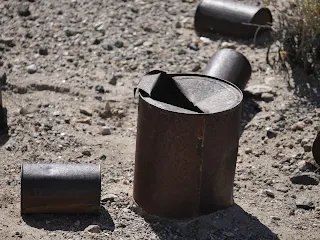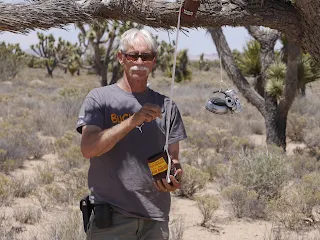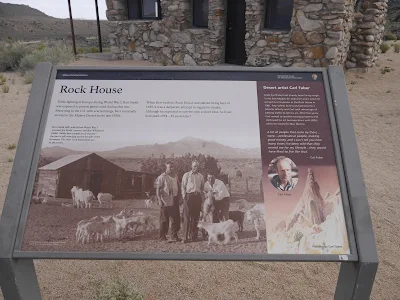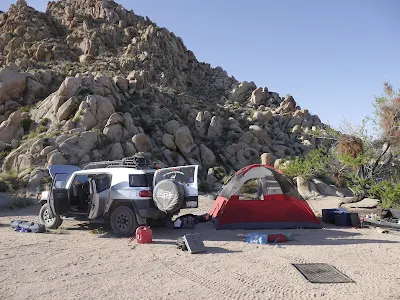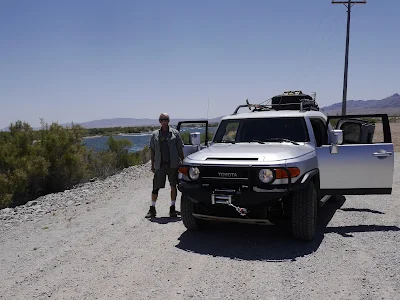 |
| Road less traveled - better have a GPS! |
In Southern California there are two main arteries that flow through the Mojave Desert which are lifelines to the Colorado River and Las Vegas - Highways 15 and 40 are traveled more than most other black topped road surfaces in the United States. Millions of travelers per year drive these highways in search of gambling fortunes, cool river life, or just points beyond - what they both share is miles upon miles of desert landscape.
Towns such as Essex, Baker, Yermo, Barstow, Ludlow and numerous other exits (actually there aren't that many) are mere pinpoints on a map. The traveler drives and looks out the window at cactus, sage, blowing tumbleweeds and thousands of square miles of brown desert dirt.
This is the place Patton trained his tank crews for the operations in North Africa during WWII - it's desolate - it's lonely - it's rough and it's the right place for an adventure.
 |
| General Patton in the Mojave Desert during WWII |
J along with his trusty companion Paul decided to drive or better yet maneuver the Mojave Road - that stretch of nearly 140 miles dirt path that parallels the 15 and 40. It's the road which both native Americans traveled for hundreds of years as well as pioneers in the 1800's moving to the promised land. It's rough, dirty, a bit scary, and bloody hot - especially at the end of May and beginning of June where temperatures can easily reach over 100. It did - 102 and 103.
Laureen stayed poolside at home - the thought of night after night tenting in open hot rough country didn't appeal to her this time - dipping her feet into cool water did. This from the woman who loved the Amazon Rain Forest - well not really loved it but went along on that adventure wholeheartedly - the Mojave Road was a different matter. Besides who would look after the four doggies on the home-front?
The boys left on the morning of the 29th of May heading to the Avi Resort on the Colorado River - that would be the jumping off point.
 |
| Paul with the Colorado River in the background - the beginning. |
Research had been conducted, maps printed, warnings of traveling in only one vehicle discussed and then put away, and the most important tool purchased. A Mojave Road guidebook by Dennis Casebier was a must since this individual has traveled the road more times than anyone could count and the directions - starting off at Avi - were right on with exact mileage and GPS coordinates.
 |
| A Must if you want to be safe! |
As stated this was not a trip for the faint of heart - this would be like going back in time to follow the footpaths and wagon wheels of those who have gone on before us - the true pioneers who risked it all in an unforgiving desert for a better life. Unlike those John and Paul called once again on the intrepid Toyota FJ - the workhouse of so many of our blogs. The vehicle which has never let J and L down.
New tires, new steel rims, new off road bumper and a 9,000 pound winch were added to the FJ to ensure she (hope that's not taken as sexist) was ready for an off road ordeal. All research stated not to do the trip in one vehicle but one vehicle was all we had.
With the top rack loaded with an extra tire (the FJ already has a spare on the rear door) in case we encountered two blow outs, shovel, hard gravel rake, floor jack we were confident in the tire area. Plenty of water, extra gasoline, tent, cots, and all the other camping needs made us feel that we would at least have some comforts of home on this trip. The FJ was jammed packed with supplies but when the trip is supposed to take three days and may stretch into four one has to be prepared - cell phones are spotty at the best being this remote (in fact John was completely off the grid for nearly 36 hours and Paul's cell didn't do much better).

We followed Dennis's guidebook and learned that the desert isn't a place which is only brown but one of pure beauty and brimming with life. No, while driving on the 15 or 40 a person may look out at the brown of the desert and believe there is nothing worthwhile to view but they are totally wrong - there is so much to see and learn about the Mojave Desert - the only problem is its remoteness and sometimes unforgiving nature.
This road - this Mojave Road is only for four wheel drive vehicles and is only for those who want to get out of their comfort zone to learn the truth about what a beautiful and vibrant world there is between to long lines of black top.
In the next four or five blogs more details on this trip will be written about - hopefully the readers will learn to understand and love this piece of history - this road had to offer.
 |
| Not far from the Avi Resort |
We explored and gained knowledge about this part of Southern California we hadn't known existed.












